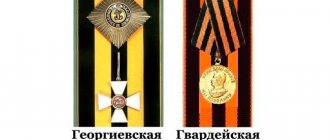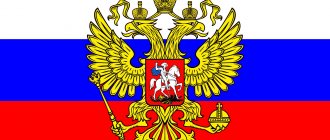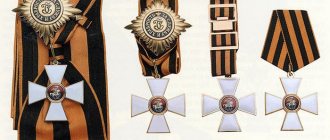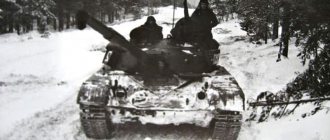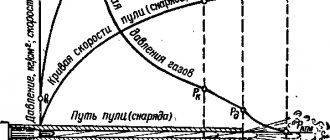The tradition of decorating your clothes with a bright orange ribbon with longitudinal black stripes appeared relatively recently. People called it St. George's ribbon, confusing it with the royal award ribbon introduced under Catherine II. It had two yellow and three black stripes, which symbolized the state emblem, although there are opinions that these colors meant gunpowder and fire, or smoke and flame.
With the coming to power of the Bolsheviks, the royal decorations were completely abolished. They were remembered only at the end of 1941, when the people, exhausted by the war, needed an incentive. Thus, the guards ribbon became a continuation of tradition, preserving the symbolic meaning of the imperial award.
The history of the Guards Ribbon
After the exhausting battle near Yelnaya, on September 18, 1941, an order was issued to rename the motorized rifle formations that distinguished themselves during the battles near Smolensk into the 1st, 2nd, 3rd and 4th Guards Rifle Divisions.
The prefix “Guards” instantly became prestigious, which could only be received for services to the fatherland. Thus, Panfilov’s men were among the first to receive the honorary title for their heroism during the Battle of Moscow. During the entire period of the Great Patriotic War, not only formations and individual units of the Soviet Army, but also ships that distinguished themselves in battles with the enemy received the guard rank.
Due to the difficult situation in the country, the introduction of a new military uniform for privileged units was not possible.
Therefore, the issue of assigning employees to the guard was resolved with minimal costs. On May 21, 1942, the Presidium of the USSR Armed Forces established a single breastplate insignia “Guard”.
Wearing a single breastplate insignia was expected by all guards units, regardless of the type of troops. But the leadership of the USSR Navy decided to create their own insignia, the idea of which was proposed by Captain 2nd Rank B.M. Khomich.
The distinctive guards badge for employees of the USSR Navy consisted of a rectangular plate, which was covered with a black and orange ribbon. The ribbon itself, which outwardly resembled the St. George ribbon, was called the Guards ribbon. It was also attached to caps, leaving the ends free. These insignia were officially approved on June 19, 1942.
The history of the appearance of the Guards ribbon, which differs from the St. George ribbon
During the Great Patriotic War, among the Soviet marshals were former non-commissioned officers of the First World War. They were Georgy Zhukov, Konstantin Rokossovsky and others. They had military awards in the form of the Order of St. George. Despite the fact that after the revolution their presence was a disadvantage for a military career, everything changed in 1944. The Council of People's Commissars equated them to holders of the Order of Glory if the awards were received during the war of 1914-1917.
On November 8, 1943, the Order of Glory was established on the territory of the Soviet Union, which was an analogue of the Order of St. George. The cross was replaced with the star familiar to Soviet citizens, and the yellow color was replaced with orange. At the same time, the number of degrees was reduced. Thus, the guards ribbon appeared, which became a symbol of the Soviet guard. Due to this circumstance, her image began to be used on various posters and greeting cards.
Stages of formation of the guards ribbon
Initially, the ribbon served only as an insignia, which was also used on guards banners. But a year later, this piece of fabric, designed to raise the morale of officers and soldiers, and also aimed at glorifying the war, became one of the important elements for several military awards:
- The Order of Glory is a soldier’s award, in addition to privates and junior command staff of the Red Army, the order was awarded to junior lieutenants of aviation units.
- The medal for the “Capture of Berlin” was intended for all participants in the assault on Berlin. Despite the huge number of projects, the final version only had the inscription “For the capture of Berlin” and the year of the fall of the German capital on May 2, 1945. More than 1 million people were awarded the medal.
- Medal for “Victory over Germany”. The technical committee was tasked with creating a medal for the end of the war with Nazi Germany at the end of 1944. As a result, the medal was designed in record time according to the sketches of Romanov E.M. and Andrianova I.K. All military personnel could receive the medal.
- “Anniversary” post-war medals.
Perhaps the most prestigious award of the Second World War is the Order of Glory, which was established by order of Stalin on November 8, 1943. It is believed that the prototype of the award was the St. George Cross of the Russian army, but unlike the imperial award, the Soviet order had not four, but three degrees. The Order of Glory, like the “Victory”, had the shape of a star with a block covered with a two-color ribbon.
The main task of the order was to stimulate ordinary soldiers and junior command staff. It was issued only for personal merits demonstrated during battles and other military actions.
In the post-war years, guards ribbons symbolized the military actions of the Second World War and subsequently began to be used in anniversary awards that were awarded to veterans on the anniversary of the victory.
In 2000, the St. George (Guards) ribbon became part of the award system and adorned the St. George Cross, an award for particularly distinguished military personnel.
Peacekeepers were the first to receive the new order in 2008, after Georgia’s armed attack on North Ossetia.
Guards or St. George's ribbon?
On the eve of May 9, the topic of “St. George’s Ribbons” and the ethics of their use was again raised in Russian society. Many reasonably argue: did this still tsarist symbol have anything to do with the period of the Great Patriotic War? Let's try to figure it out and dispel myths and speculations by dotting the i's in our material.
Birth of a symbol: yellow, not orange
The St. George Ribbon was originally established by Catherine II on November 26, 1769 during the Russian-Turkish War of 1768-1774 to encourage loyalty, courage and prudence for the benefit of the Russian Empire. The film received its name from the name of St. George the Victorious.
However, according to the description, the tape was black and yellow “with three and two stripes.” Only the 1913 statute stated: “A ribbon of three black and two orange stripes, worn over the right shoulder.”
Full bow of the St. George's Cross
The ribbon was widely used and gained national fame in such awards as the St. George Cross (soldier's "Egory") of four degrees and St. George medals also of four degrees.
In addition, the standards of particularly distinguished regiments were crowned with such ribbons.
Ribbon as an independent award
One of the important subjects of modern discussion is the ethics of arbitrary wearing of the St. George Ribbon. Currently, it can be found anywhere: on car antennas to backpacks and other types of clothing. The main argument of opponents of this phenomenon is that the ribbon must be earned.
St. George medals with the image of Nicholas II
Indeed, history knows such examples. Thus, in some cases, the St. George Ribbon was used as an analogue of the corresponding award; in cases where holders of the Insignia of the Military Order could not receive the Badge itself (for example, during the defense of Sevastopol in 1854-1855), they wore the St. George Ribbon on their uniform. During the First World War, the St. George Knights also wore the St. George Ribbon in the winter over the side of their overcoat.
Cossack Konstantin Nedorubov was a full Knight of St. George and at the same time a Hero of the Soviet Union
In addition, this is the only time that the St. George Ribbon acquired the status of an independent award. This happened in 1914, when for his services in carrying out mobilization, Lieutenant General A. S. Lukomsky was awarded the St. George Ribbon to the Order of St. Vladimir, 4th degree, which he already had (the Order of St. George for mobilization itself could not be given due to its status ). Thus, he became the owner of a unique award - the Order of St. Vladimir on the St. George Ribbon. The award was jokingly called “Vladimir Georgievich.”
White movement and collaborators
Numerous armies of the White movement during the Civil War in Russia, in various variations and in awards, used the ribbon as a distinctive sign.
Later, the ribbon of the Order of St. George was used in the symbolism of Russian emigrant organizations, such as the Russian All-Military Union. The symbol of the collaborationist “Union for the Struggle against Bolshevism” created in 1944 in Bobruisk was the “St. George Banner with the St. George Cross embroidered in silver in the middle.” The leaders of the organization wore armbands of St. George’s colors on their sleeves.
The period of the USSR and WWII is the Guards Ribbon
With the advent of Soviet power, all the old royal paraphernalia and the system of awards were abolished. But with the beginning of the war, a ribbon of similar appearance reappeared on the soldiers’ medal blocks. In particular, the established award for junior staff of three degrees - the Order of Glory - just received a black and orange ribbon. But of course there could be no talk of any “St. George’s” ribbon.
Soviet poster
It is alleged that these awards became a tribute to the St. George Crosses, as indeed they had much in common in their statute, but this has not been officially confirmed anywhere. By the way, the word “guards” is also not in the description of the orders.
So what kind of tape was there during the Great Patriotic War? And the answer is still Gvardeyskaya.
Order of Glory of three degrees with Guards Ribbon
Since the autumn of 1941, units, formations and ships, for the courage and heroism of their personnel, which they showed in defending the Fatherland, were awarded the honorary title “Guards”, “Guards”. By decree of the Presidium of the Supreme Soviet of the USSR of May 21, 1942, the “Guard” badge was established for guardsmen. Despite the fact that the “Guard” badge was established as a single one, the USSR Navy decided to establish its own guards badge (popular name - “Sea Guard”).
Sailors of the USSR Navy at the Victory Parade in Moscow
The People's Commissar of the Navy, Admiral Nikolai Kuznetsov, by his order No. 142 of June 10, 1942, approved these insignia. In this order it is called “Guards”. And on May 5, 1943, he also approved the publication “An Illustrated Description of the Insignia of Personnel of the USSR Navy,” in which her image is signed under the same name.
From the description:
The Guards Ribbon is a golden-orange silk moire ribbon with three longitudinal black stripes applied to it. Tape width - 32.5 mm, length - 1420 mm. The width of the black stripes is 6 mm, the width of the orange gaps between them is 6.25 mm, the width of the edging is 1 mm.
Description of the guards insignia on the uniform of the USSR Navy
The Guards ribbon is laid along the band of the Red Navy caps (peakless caps) of enlisted personnel of Guards ships and units and is secured at the rear seam, with the ends of the ribbon remaining free. On the guards' ribbons, in the place in front of the cap, the name of the ship, unit or formation is stamped in gold, and on the free ends - anchors.
So there is no doubt: it is the Guards Ribbon that is directly related to the period of the Second World War. At least the symbol bore that name.
When did the change in concepts occur?
With the start of the “St. George Ribbon” campaign in 2005, in the Russian media, the Soviet “Guards Ribbon” also began to be called “St. George’s Ribbon”. But unlike the order ribbon, it began to be issued to everyone.
Orders of a WWII veteran: it is clear that the Guards ribbon adorns the Order of Glory, 3rd degree, and the medal “For Victory over Germany.” Photo by Rostislav Zhuravlev
This caused intense criticism from certain public organizations. In particular, one of the symbols of reluctance to participate in the “St. George’s Ribbon” campaign was a poster issued in Russia with the inscription: “I don’t need the St. George’s Ribbon - I have no right to wear it!”
By the way, the St. George ribbon has also officially entered the state award system since 2000 and now crowns the Crosses of St. George, which are awarded to military personnel for distinguished service on the battlefield. The first awards took place in 2008 after the armed conflict on the border with Georgia.
“Russian Spring” and the war in Donbass 2014
Blockade of the Supreme Council of the Republic of Crimea in Simferopol a few days before the referendum. Photo by Rostislav Zhuravlev
The St. George Ribbon acquired a new meaning during the “Russian Spring” in Crimea and South-East Ukraine. The black and yellow ribbon has become a symbol of resistance to the “Kyiv junta”, which came to power in the neighboring country as a result of the coup d’etat on the Maidan.
Supporters of federalization during protests in Lugansk, March 2014. Photo by Rostislav Zhuravlev
As a result, in many republics of the former USSR the tape was actually banned. For example, recently, even in Belarus, its official use during the celebration of May 9 was abandoned, and in Ukraine, its use can lead to real imprisonment and charges of “terrorism” or “separatism.” In the Baltic countries, St. George's ribbons may also soon fall under a direct legislative ban, like Soviet and other Russian symbols.
Military equipment of the LPR people's militia with St. George symbols on the BMP turret. In the photo is Rostislav Zhuravlev
During armed clashes in the Donbass, militia units identified themselves with “St. George’s” colors: corresponding images were applied to military equipment, and the ribbons themselves were tied or sewn to clothing or wound on the left shoulder strap. And this had less of a symbolic and more of a practical meaning for the “friend or foe” identification system. Ukrainian formations used lemon color on their armbands and two white parallel stripes on their equipment.
Rostislav ZHURAVLEV
Promotion "St. George's Ribbon"
Soviet stamp
The modern Cross of St. George has been awarded since 2008 by the President of Russia
Medal for "Victory over Germany"
Medal "For the Capture of Berlin"
1+
Patriotic meaning of the guards ribbon
The bright orange ribbon with longitudinal black lines became a symbol of victory over fascism. However, its patriotic significance should be attributed to an earlier period, when a similar distinctive sign, named in honor of St. George the Victorious, was introduced by Catherine II. Unlike its “descendant,” the St. George ribbon, in addition to decorating orders, also acted as an independent award, which was given for courage shown in battle and service for the good of one’s Fatherland.
Introduced in 1942, the Guards insignia for soldiers who went through the First World War and found Tsarist Russia echoed the St. George insignia and aroused feelings of pride. And it was not for nothing that the Soviet government at that time, not caring about ideology, decided to return to the roots, reminding everyone of the great history of the country. This was necessary to raise spirits and understand how important it is to win, no matter what.
Of course, the imperial and Soviet ribbons are symbols of two different eras, but for ordinary soldiers who fought not for money or glory, but for the Motherland and for the good of the Fatherland, the ribbon has a special meaning, and it doesn’t matter what it’s called, because that’s what makes sense does not change.
Today, the guards ribbon is not just a symbol of victory, but a symbol of memory of those who fell on the battlefield and those who returned home, of the soldiers who emerged victorious in the fight against Nazism.
St. George's ribbon after the revolution
The glorious symbol existed in the Russian imperial army until the collapse of the country. After the Bolsheviks came to power, all military attributes and traditions of tsarist power were abolished. The main banner of the young socialist republic was a red banner with a hammer and sickle. At the same time, many Red commissars and commanders had St. George's crosses, which were awarded back in tsarist times. For example, the famous Semyon Budyonny was a full holder (awarded four times) of this award and even received it five times. But, as historian Boris Sokolov writes in the book Budyonny: Red Murat, he was deprived of the very first cross for assault.
Of course, at that time no one would have dared to openly wear “George” or a ribbon in the Red Army - they could have put him up against the wall without thinking. But in the White movement, the St. George Ribbon became a kind of symbol of resistance. It was used as part of awards and separately - on chevrons, headdresses, and in the form of bows. The ribbon was often used as an identification mark for veterans of the movement, as opposed to recruits, who had to earn the right to wear it.
Perspective of the Guards Ribbon
At the beginning of the 21st century, the concepts of St. George's and Guards ribbons were replaced. In 2005, in honor of the 60th anniversary of the victory, the “I Remember” campaign was launched, the symbol of which was the guards ribbon, for some reason called St. George’s. This is exactly what people began to call it, although in reality, since 1917, there could be no talk of any George.
In 2014, the guards ribbon acquired a new symbol for the residents of Donbass, who were involved in a civil war due to their refusal to submit to the new government that came to power as a result of the coup.
Today, there is an increasing debate that the guards insignia has nothing to do with victory, and it is unacceptable to use it during the celebration of May 9th. Opponents of this symbol argue their position by the fact that the St. George ribbon in Imperial Russia was a state award that had to be earned. In addition, it is proposed to replace the guards ribbon with a red one, since it was the red banner that rose above the Reichstag.
But it’s not about merit or awards; the traditional symbol has a deeper meaning.
It was possible to earn the wearing of the order only by courage and bravery. And in fact, it was thanks to dedication and incredible fortitude that the Soviet army was able to change the course of the war, emerging victorious.
Wearing a guards ribbon by civilians does not at all mean appropriating the victory of the Soviet army, in the ranks of which all the peoples of the Soviet republics were represented. And in general, it doesn’t matter what exactly red or orange with black stripes will ultimately become a symbol of victory, the main thing is to remember the feat of the Soviet people in order to prevent a repetition of past mistakes.
Difference between St. George and Guards ribbon
The difference between the Guards and St. George ribbons is largely historical: they were used in different eras and related to different awards, but in essence they were awarded only to the most worthy for truly important heroic deeds.
| Georgievskaya | Gvardeiskaya | |
| Orders |
|
|
| Who was not awarded | Guards units | Officers |
| Color | Black and gold, black and yellow, black and orange | Only orange and black |
| Appearance time | 1769 | 1941 |
| era | Royal Russia | USSR |
The external difference is in a small edge
How to wear the St. George's ribbon correctly?
The best place for St. George's
ribbons - on the chest near the heart.
It is attached on top of clothing, for example, on the lapel of a jacket, coat, dress or breast pocket of a shirt. Such recommendations are given by participants in the “ St. George’s Ribbon
” campaign from the public movement “Volunteers of Victory.”
Interesting materials:
How to remove a stain from a stone countertop? How to remove stains from lacquered furniture? How to remove a stain from a table? How to remove yellow stains from tulle? How to remove yellow stains from kitchen towels? How to remove yellow stains from sheets? How to remove a greasy stain from a wooden surface? How to remove a greasy stain from an apron? How to bring up bios on Acer? How to call bios on hp?
Medal "For Victory over Germany"
One of the most popular medals of the USSR, “For Victory over Germany,” also used a guards ribbon. The popularity of this medal is due to the fact that it was awarded not only to soldiers of the Soviet army, but also to other citizens of the USSR who, through their actions at the front or in the rear, helped the regular army.
The medal was round in shape and made of brass. Using a ring with an eye, it was attached to a block, which was covered with a guards ribbon of traditional colors.
